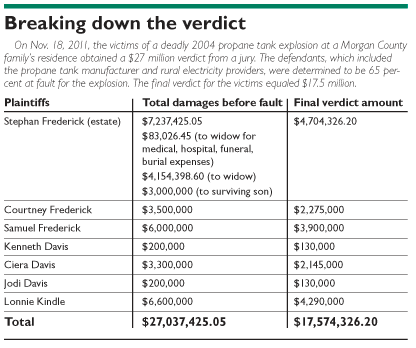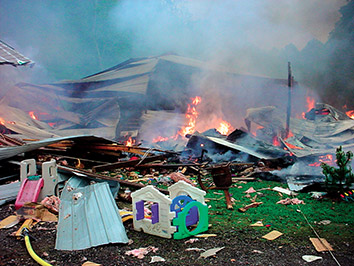Subscriber Benefit
As a subscriber you can listen to articles at work, in the car, or while you work out. Subscribe NowSeven years ago, a propane water heater explosion leveled an apartment attached to a rural Morgan County barn, resulting in one man’s death and six of his family members being severely burned.
A liability lawsuit filed by the victims a year after the May 2004 blast went through years of pretrial proceedings and discovery disputes, and this November the family received a jury verdict of $27 million. With liability split between the property owner and defendants, the final damages amount translates to $17.5 million.
Plaintiffs’ attorney David Herzog believes that final verdict may be the largest in the county’s history, but the litigation is far from finished as the parties continue debating attorney fees and an appeal is planned. Legal lessons from the litigation are focused on what led to the $27 million verdict and liability-limited amount, how the issue of post-traumatic stress disorder played into the trial and the question about what monetary amount is warranted in these types of situations.
“We are pleased with the jury’s verdict,” said Herzog, an attorney with Baker & Daniels in Indianapolis. “This has been a very long process and it’s been quite an ordeal for our clients. They suffered not only horrific injuries and the loss of a husband and father, but they continued to suffer from emotional distress. That was a key part of this case and received considerable attention at trial.”
At the heart of the litigation is the May 12, 2004, explosion at the farm located about 12 miles northwest of Martinsville. The owners, William and Betty Kindle, were away on a 50th anniversary cruise and their granddaughter, Courtney Frederick, agreed to house-sit. Her husband, Stephan, and 2-year-old son, Samuel, were with her, as well as her uncle, Lonnie Kindle; 2-year-old cousin, Sierra Davis; and Sierra’s parents, K.C. and Jodi Davis.
They were all sleeping inside when the explosion happened shortly after 7 a.m., and Stephan was killed while the others were burned. The victims sued a year after the incident and discovery disputes ensued before the liability trial happened in 2010. Marion Superior Judge Robyn Moberly began as special judge in late 2008 after one of the utility defendants asked for a new judge in the case that would end up with more than 200 motions and filings and lead to a three-week jury trial.
Last year, the jury decided South Central Indiana Rural Electric Membership Corp., RushShelby Energy Rural Electric Cooperative and SCI Propane LLC were 65 percent liable for the accident, and that Courtney’s now-deceased grandfather shouldered the remaining 35 percent liability.
A side issue about what defendants needed to turn over in discovery arose. Last year, the Court of Appeals reversed a sanction against defendant water-heater maker White-Rodgers that Moberly had imposed for not turning over certain material in the litigation. The appellate panel found White-Rodgers had turned over what it needed to and reversed the sanction. At trial, the jury found White-Rodgers wasn’t liable in the explosion.
In November 2011, the damages aspect of the trial took place and found the defendants at fault for $17.5 million in damages for the victims. Herzog said it’s too early to know what amount the plaintiffs might actually receive, depending on the appeal. He didn’t know any details on how the money could be used if the verdict is upheld.
“As inadequate as it may be, money is the only way our system compensates people in these circumstances and that jury found that was necessary in this case,” he said.
For the damages trial, Herzog spent part of the trial telling the jurors about the explosion from Courtney’s perspective. When trying to escape the burning house in the explosion’s aftermath, the then-28-year-old mother grabbed her young son and pushed her husband and uncle outside through a hole in the living room wall, burning her arms and other parts of her body. She went back inside and scooped up Sierra, saving the girl’s life.
Aside from telling the story of what happened in the explosion, Herzog said a key strategy in the damages trial was emphasizing the emotional distress and post-traumatic stress disorder that resulted from the tragedy. The plaintiffs called in the treating physicians and burn unit nurses, as well as mental health professionals and experts in PTSD. While testimony from experts on the economic losses the victims faced as a result of the tragedy is the same type of evidence presented in any personal injury or wrongful death case, Herzog said the emotional and mental health experts’ testimony was more unique.
“I think the post-traumatic stress aspect factored more heavily in this case than most, that would be my suspicion,” Herzog said.
 Defense attorneys in this case questioned whether the victims did enough to treat and deal with their emotional distress and PTSD. The plaintiffs’ counsel offered expert testimony and evidence proving how common it is for victims to not want to trigger memories of the incident and to avoid some treatment. Experts said that while the incident itself was traumatic, the post-explosion treatment and burn therapy was also traumatic and factors into the damages discussion. Adults can rationally understand what is happening but children, such as the pair of 2-year-olds who were burned, cannot reason through that experience. Another related aspect that surfaced was whether any certain amount of damages was needed and what that might mean for the victims.
Defense attorneys in this case questioned whether the victims did enough to treat and deal with their emotional distress and PTSD. The plaintiffs’ counsel offered expert testimony and evidence proving how common it is for victims to not want to trigger memories of the incident and to avoid some treatment. Experts said that while the incident itself was traumatic, the post-explosion treatment and burn therapy was also traumatic and factors into the damages discussion. Adults can rationally understand what is happening but children, such as the pair of 2-year-olds who were burned, cannot reason through that experience. Another related aspect that surfaced was whether any certain amount of damages was needed and what that might mean for the victims.
Other personal injury attorneys in Indiana say the PTSD aspect doesn’t surface in litigation as much as other related issues, such as emotional distress, which involves some of the same litigation elements in testimony and evidence.
In Indianapolis, plaintiff lawyer Scott Montross said he’s only been involved in one PTSD case and said the common challenge in those types of cases involves the disorder not being diagnosed immediately after a traumatic event. The condition affects people in different ways, with some suppressing it entirely while others obtain limited counseling. Montross said he has consistently found in more than 40 years of litigating that clients deposed a year or more after an incident will sometimes breakdown as soon as the questions gets anywhere close to what happened with the traumatic event.
“As for the damages amount associated with this area, I’m convinced these damages are every bit as real as the physical injuries,” Montross said. “In fact, while the physical can eventually subside, the emotional piece can be another issue altogether. I’ve told juries before and will tell them again, when you get into these size damages, it isn’t how much, as it is whether the harm has been balanced. And the extent of the harm is a function of the evidence presented.”
Defense attorney Kent Frandsen with Parr Richey Obremskey Frandsen & Patterson declined to comment about factual or legal rulings in the lawsuit since the case is still pending before the trial judge on an attorney fees issue and an appeal is planned on the damages aspect.
“We will ask the appellate court to review several matters, including the judge’s post-verdict reallocation of the jury’s findings of fault,” Frandsen said. “Almost half of the damage award is for fault the jury found to be the responsibility of non-party Midland-Impact, not the SCI Propane companies. Also, we believe insufficient evidence was presented to support any finding of fault by SCI in this case.”•
Please enable JavaScript to view this content.

